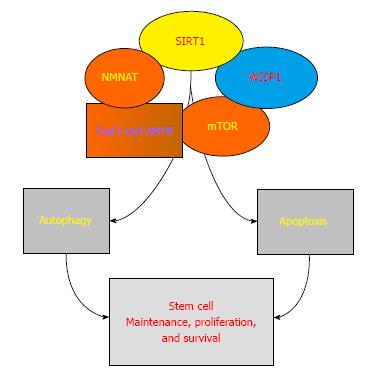Copyright
©The Author(s) 2015.
World J Stem Cells. Mar 26, 2015; 7(2): 235-242
Published online Mar 26, 2015. doi: 10.4252/wjsc.v7.i2.235
Published online Mar 26, 2015. doi: 10.4252/wjsc.v7.i2.235
Figure 1 Schematic of SIRT1 pathways that can influence stem cell maintenance, proliferation, and survival.
Several pathways can control SIRT1. For example, NMNAT can modulate the deacetylating activity of SIRT1, FoxO1 can govern SIRT1 transcription and increase SIRT1 expression, and AMPK can increase the cellular NAD+/NADH ratio leading to the deacetylation of downstream SIRT1 targets. SIRT1 subsequently can depress mTOR pathways and promote autophagy to preserve stem cell integrity during oxidant stress as well as promote neuronal growth. In addition, SIRT1 is necessary to initiate autophagy and transition cells from a quiescence state to an active state. WISP1 increases SIRT1 activity to protect cells from oxidative stress and apoptotic injury and blocks SIRT1 caspase degradation. NMNAT: Nicotinamide/nicotinic acid mononucleotide adenylyltransferase; mTOR: Mechanistic of rapamycin; AMPK: AMP activated protein kinase.
- Citation: Maiese K. SIRT1 and stem cells: In the forefront with cardiovascular disease, neurodegeneration and cancer. World J Stem Cells 2015; 7(2): 235-242
- URL: https://www.wjgnet.com/1948-0210/full/v7/i2/235.htm
- DOI: https://dx.doi.org/10.4252/wjsc.v7.i2.235









